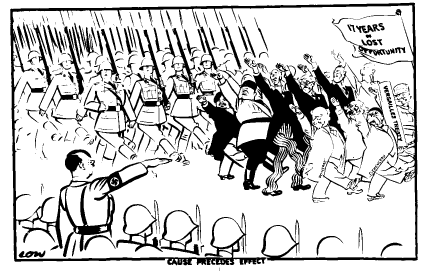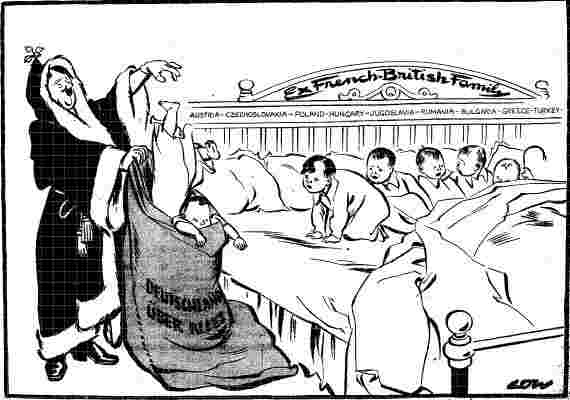|
| ||
Most of the aggressions, leading step by step to open war in September 1939, were the outcome of the deliberate policy of Hitler. S Reed Brett, European History 1900-1960 (1967).
A country which is determined to have a war can always have it. Historian and British Cabinet minister H.A.L.Fisher, A History of Europe (1938).
|
Going DeeperThe following links will help you widen your knowledge - particularly, follow the links which offer you 'more info' on each event: Prof Rempel on Nazi diplomacy (difficult) Frank E Smitha - online book HARD
|
|
1. Saar PlebisciteThe Treaty of Versailles had put the Saar under the control of the League of Nations for 15 years. In 1935 the inhabitants of the Saar voted to return to Germany. The Saar plebiscite is cited by many historians as the first step to war.
|
The Saar Plebiscite - more info |
|
2. Conscription & Re-armamentHitler began to build up his armed forces. In 1935 he introduced conscription (calling up men to the army). This broke the Treaty of Versailles. As a response, in April 1935 Britain arranged a conference with France and Italy, where they signed the Stresa Front agreement promising to maintain the Locarno Treaties of 1925 and to defend Austria against Germany. However, Britain was negotiating with Hitler even as the conference was taking place, and in June 1935 signed the Anglo-German Naval Agreement with Germany - not only had the British let Hitler get away with re-armament, they actively helped him to do so!
|
Rearmament in Germany - more info The Stresa Front, 1935 - more info Hitler builds the Axis - more info Axis Militarism - sets Nazi re-armament in its wider setting. |
|
|
|
◄ Source AThis drawing by the British cartoonist David Low (20 March 1935) is titled 'Cause comes before effect'. Four days earlier Hitler had held his 'Freedom to Rearm' military rally where he denounced the disarmament clauses of the Versailles Treaty and announced the reinstatement of conscription in Germany. Click here for the interpretation
|
|
3. RhinelandHitler invaded the Rhineland on 7 March 1936 (Operation Winter Exercise). This broke the Treaty of Versailles. It was a bluff – the German army had only 22,000 soldiers and had orders to retreat if they met any resistance. But once again, Britain and France did nothing.
|
The Re-occupation of the Rhineland - more info Infographic from versushistory |
|
4. Anschluss with AustriaThere had already, in 1934, been one attempt to unite Austria with Germany by Austrian Nazis, who had assassinated the Austrian Chancellor Dollfuss in an attempted 'July Putsch' ... which had been prevented only when Mussilini in Italy threatenned war. In 1938, Hitler took over Austria. First, Hitler encouraged the Austrian Nazis to demand union with Germany. Then, on 11 March 1938, the planned invasion of Austria took place ('Operation Otto'). This broke the Treaty of Versailles, but Britain and France did nothing.
|
YouTube Anschluss - documentary
|
|
|
|
◄ Source BThis cartoon was drawn by the British cartoonist Bernard Partridge for the satirical magazine Punch in February 1938. It shows Hitler as a poacher, stealing Austria. Mussolini is shown as a bad game-keeper, failing to stop him; ‘I never heard a shot, Adolf’’, he is saying. Click here for the interpretation
Consider:Does the fact that the cartoonist of Source B is misrepresenting Austria mean that it is an unreliable source?
|
|
5. MunichIn 1938, Hitler tried to take over the Sudetenland. First, Hitler encouraged the Sudeten Nazis to demand union with Germany. Then, Hitler made plans to invade Czechoslovakia. Neville Chamberlain appeased Hitler. At Munich, on 29 September 1938, Britain and France gave Hitler the Sudetenland.
|
Sudeten Crisis - more info
YouTube Hitler and Czechoslovakia - old educational video (very biased)
|
|
|
|
◄ Source CThis British cartoon from October 1938 (by Low, who hated Nazi Germany) shows Hitler as Santa, popping into his sack, one-by-one, little countries – who had got into bed with the ‘French-British family’. His sack says: Deutschland Uber Alles (‘Germany over all’). The caption reads: 'Europe can look forward to a Christmas of peace' (Hitler). Click here for the interpretation
Consider:What is the cartoonist of Source C saying about Hitler?
|
|
6. CzechoslovakiaOn 15 March 1939, Hitler’s troops marched into the rest of Czechoslovakia. This, for most British people, was the time when they realised that the only thing that would stop Hitler was a war.
|
The Story of Czechoslovakia - more info How Czechoslovakia helped provoke war
|
|
7. USSR/Nazi PactIn summer 1939, Hitler began to unfold his plan to take over Poland. First, the Germans in Danzig demanded union with Germany. Then, Hitler threatened war. Chamberlain promised the Poles that Britain would support them if Germany attacked Poland. In August 1939, Hitler made a secret treaty with Russia. He thought this would stop Britain & France helping Poland.
|
Nazi-Soviet Pact - more info
|
|
8 PolandIn April 1939, Chamberlain announced the 'Polish Guarantee' - a promise to defend Poland if Hitler invaded (this was the event which ended appeasement).
On 1 September 1939, Hitler invaded Poland. On 3 September 1939, Chamberlain declared war on Germany.
|
How the Polish Guarantee helped provoke war - short note Eight reasons Hitler invaded Poland
YouTube Invasion of Poland - old educational video
|
|
Consider:1. List the 'eight steps' on Hitler's 'Road to War'. For each step, explain how it 'went further' than the previous, so as to establish the progression ('escalation') of Hitler's actions. 2. List all the facts which support Reed Brett's interpretation that: 'Most of the aggressions, leading step by step to open war in September 1939, were the outcome of the deliberate policy of Hitler.' Do you agree: DID Hitler intend war from the beginning?
|
|
|
|
| ||


